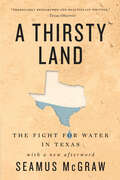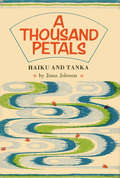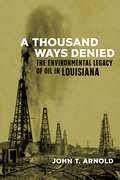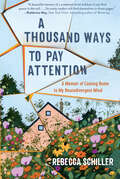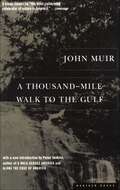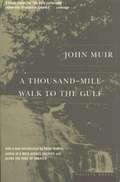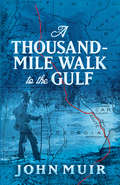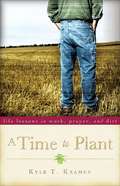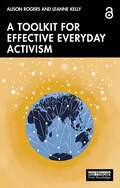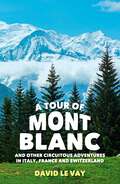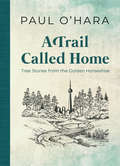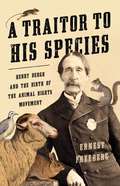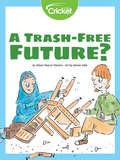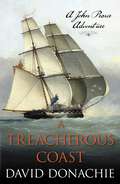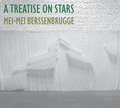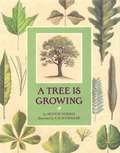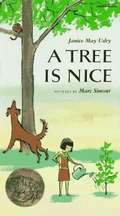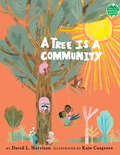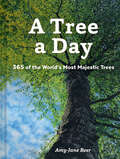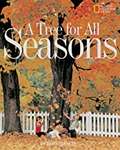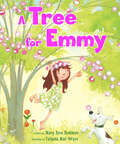- Table View
- List View
A Thirsty Land: The Fight for Water in Texas (Natural Resources Management and Conservation)
by Seamus McGraw“An important story not just about [Texas’s] water history, but also about its social, economic, and political identity” (Western Historical Quarterly).As a changing climate threatens the whole country with deeper droughts and more furious floods that put ever more people and property at risk, Texas has become a bellwether state for water debates. Will there be enough water for everyone? Is there the will to take the steps necessary to defend ourselves against the sea? Is it in the nature of Americans to adapt to nature in flux?The most comprehensive—and comprehensible—book on contemporary water issues, A Thirsty Land delves deep into the challenges faced not just by Texas but also by the nation, as we struggle to find a way to balance the changing forces of nature with our own ever-expanding needs. Part history, part science, part adventure story, and part travelogue, this book puts a human face on the struggle to master that most precious and capricious of resources, water. Seamus McGraw goes to the taproots, talking to farmers, ranchers, businesspeople, and citizen activists, as well as to politicians and government employees. Their stories provide chilling evidence that Texas—and indeed the nation—is not ready for the next devastating drought, the next catastrophic flood. Ultimately, however, A Thirsty Land delivers hope. This deep dive into one of the most vexing challenges facing Texas and the nation offers glimpses of the way forward in the untapped opportunities that water also presents.“A hard look at a hard problem: finding sufficient water to live in a place without much of it. . . . McGraw’s fine book serves as a useful guide. Observers of Western waterways will want to have this on their shelves alongside the likes of Marc Reisner and Charles Bowden.” —Kirkus Reviews“In stark prose that often gleams like a bone pile bleached in the sun, McGraw travels back and forth across Texas to give a free-ranging but deadeye view of the crisis on the horizon.” —Texas Monthly“It’s hard to write about the slow creep of environmental crises like drought without resorting to shock tactics or getting lost in the weeds . . . [McGraw] draws out the conflicts in compelling ways by drilling into the plight of individual water users. Even if you feel no connection to Texas, these stories are relevant to every part of the country.” —Outside“Interviewing both scientific experts and everyday water users, [McGraw] clearly delineates the competing interests, describes political and geological reality, and makes a compelling argument for statewide water policy that utilizes modern technology and fairly weighs parochial needs against the good of the whole.” —Arizona Daily Star, Southwest Books of the Year
A Thirsty Land: The Fight for Water in Texas (Natural Resources Management and Conservation)
by Seamus McGraw“An important story not just about [Texas’s] water history, but also about its social, economic, and political identity” (Western Historical Quarterly).As a changing climate threatens the whole country with deeper droughts and more furious floods that put ever more people and property at risk, Texas has become a bellwether state for water debates. Will there be enough water for everyone? Is there the will to take the steps necessary to defend ourselves against the sea? Is it in the nature of Americans to adapt to nature in flux?The most comprehensive—and comprehensible—book on contemporary water issues, A Thirsty Land delves deep into the challenges faced not just by Texas but also by the nation, as we struggle to find a way to balance the changing forces of nature with our own ever-expanding needs. Part history, part science, part adventure story, and part travelogue, this book puts a human face on the struggle to master that most precious and capricious of resources, water. Seamus McGraw goes to the taproots, talking to farmers, ranchers, businesspeople, and citizen activists, as well as to politicians and government employees. Their stories provide chilling evidence that Texas—and indeed the nation—is not ready for the next devastating drought, the next catastrophic flood. Ultimately, however, A Thirsty Land delivers hope. This deep dive into one of the most vexing challenges facing Texas and the nation offers glimpses of the way forward in the untapped opportunities that water also presents.“A hard look at a hard problem: finding sufficient water to live in a place without much of it. . . . McGraw’s fine book serves as a useful guide. Observers of Western waterways will want to have this on their shelves alongside the likes of Marc Reisner and Charles Bowden.” —Kirkus Reviews“In stark prose that often gleams like a bone pile bleached in the sun, McGraw travels back and forth across Texas to give a free-ranging but deadeye view of the crisis on the horizon.” —Texas Monthly“It’s hard to write about the slow creep of environmental crises like drought without resorting to shock tactics or getting lost in the weeds . . . [McGraw] draws out the conflicts in compelling ways by drilling into the plight of individual water users. Even if you feel no connection to Texas, these stories are relevant to every part of the country.” —Outside“Interviewing both scientific experts and everyday water users, [McGraw] clearly delineates the competing interests, describes political and geological reality, and makes a compelling argument for statewide water policy that utilizes modern technology and fairly weighs parochial needs against the good of the whole.” —Arizona Daily Star, Southwest Books of the Year
A Thousand Petals: Haiku and Tanka
by Jinna JohnsonThis is a book of American haiku. The form is Japanese, forged by the Japanese genius to express the uniqueness of everyday life. The author writes with a refreshing, simple style, capturing the experience clearly in a few words. The reader cannot help but finish the poems with a greater appreciation of the simple things in life.
A Thousand Ways Denied: The Environmental Legacy of Oil in Louisiana
by John T. ArnoldFrom the hill country in the north to the marshy lowlands in the south, Louisiana and its citizens have long enjoyed the hard-earned fruits of the oil and gas industry’s labor. Economic prosperity flowed from pioneering exploration as the industry heralded engineering achievements and innovative production technologies. Those successes, however, often came at the expense of other natural resources, leading to contamination and degradation of land and water. In A Thousand Ways Denied, John T. Arnold documents the oil industry’s sharp interface with Louisiana’s environment. Drawing on government, corporate, and personal files, many previously untapped, he traces the history of oil-field practices and their ecological impacts in tandem with battles over regulation. Arnold reveals that in the early twentieth century, Louisiana helped lead the nation in conservation policy, instituting some of the first programs to sustain its vast wealth of natural resources. But with the proliferation of oil output, government agencies splintered between those promoting production and others committed to preventing pollution. As oil’s economic and political strength grew, regulations commonly went unobserved and unenforced. Over the decades, oil, saltwater, and chemicals flowed across the ground, through natural drainages, and down waterways. Fish and wildlife fled their habitats, and drinking-water supplies were ruined. In the wetlands, drilling facilities sat like factories in the midst of a maze of interconnected canals dredged to support exploration, manufacture, and transportation of oil and gas. In later years, debates raged over the contribution of these activities to coastal land loss.Oil is an inseparable part of Louisiana’s culture and politics, Arnold asserts, but the state’s original vision for safeguarding its natural resources has become compromised. He urges a return to those foundational conservation principles. Otherwise, Louisiana risks the loss of viable uses of its land and, in some places, its very way of life.
A Thousand Ways to Pay Attention: Discovering The Beauty Of My Adhd Mind--a Memoir
by Rebecca SchillerNow in paperback: A captivating, heralded memoir, "unflinching and full of truth" (Katherine May), of a woman making a home on a small farm while grappling with an unexpected ADHD diagnosis “When you think about ADHD . . . do you picture a woman in the bucolic English countryside, raising her children along with an assortment of animals and vegetables? Why not?”—Salon Moving to a small farm is Rebeca Schiller’s dream come true. But as her young family adjusts to a new life in the countryside, her dream is threatened by something within. I’m aware of everything, all at once, which is too much. As Rebecca’s symptoms mount—frequent falls, rages, and strange lapses in memory—her doctors are baffled and her family unmoored. Finally comes a diagnosis: severe ADHD. For Rebecca, it is the start, not the end, of a quest for understanding. As she scrambles to support both family and farm, her focus spirals: from our current climate crisis to long-extinct lynx in the shadows of ancient oaks and the forgotten women who tended this land before her, their stories hidden just beneath the surface of history. In this luminous, heralded memoir of one woman’s newfound neurodivergence, attention is not deficient—but abundant. Publisher’s Note: A different version of this book has been published under the title Earthed in the United Kingdom.
A Thousand-Mile Walk To The Gulf
by John MuirFrom one of America's greatest environmentalists, here is the adventure that started John Muir on a lifetime of discovery.Taken from his earliest journals, this book records Muir's walk in 1867 from Indiana across Kentucky, Tennessee, North Carolina, Georgia, and Florida to the Gulf Coast. In his distinct and wonderful style, Muir shows us the wilderness, as well as the towns and people, of the South immediately after the Civil War.This book makes the perfect gift for an aspiring naturalist, hiking enthusiast, or lover of southeastern terrain.
A Thousand-Mile Walk to the Gulf
by John Muir William Frederic BadeTaken from Muir's earliest journals, this book records his walk in 1867 from Indiana across Kentucky, Tennessee, North Carolina, Georgia and Florida to the Gulf Coast. In his distinct and wonderful style, Muir shows us the wilderness, as well as the towns and people, of the South immediately after the Civil War. Foreword by Peter Jenkins.
A Thousand-Mile Walk to the Gulf (Penguin Nature Library)
by John Muir William Frederic BadèAt the age of 29, naturalist John Muir set out alone for a long hike through the rural American South in the immediate aftermath of the Civil War. This volume chronicles his path from Indiana across Kentucky, Tennessee, North Carolina, Georgia, and Florida to the Gulf of Mexico. Muir chose the "wildest, leafiest, and least trodden way I could find," sketching plants along the way and recording his delighted encounters with Spanish moss, palmettos, magnolias, and other botanical wonders. Although he preferred the wilderness to settlements, Muir occasionally encountered former Confederate soldiers, freed slaves, and other residents of the region during the 1860s.This volume bridges the gap between The Story of My Boyhood and Youth and My First Summer in the Sierra. Muir's editor and biographer, William Frederic Badè, assembled it by drawing upon the decades-old journals kept by the fledgling conservationist and writer as he traversed the many miles. Badè's footnotes appear throughout the book, offering context for Muir's enthusiastic observations, which pulse with the immediacy and freshness of first impressions. Atmospheric black-and-white photographs and sketches complement the text.
A Thread Of Blue Denim: A Farm Woman's Celebration of Country Living
by Patricia P. LeimbachA collection of over 130 short meditations, once published in her local newspaper, by a farm wife of the mid twentieth century. Though many describe the kinds of rotating work and rest on a potato farm in northern Ohio, many more treat subjects like the experiences at an amusement park, dandelions, the delights on and off super highways, the ways of spending time on unexpected snow days, the ups and downs of skiing, and the hurt an old person feels when leaving home for the last time. You'll discover the often less talked about gifts of beauty in nature on a farm, the concerns and deep love of raising children, the keeping of old traditions and making of new ones. Here is a fond, heartfelt description of rural life in the Midwest told in short bursts so the tour never becomes tiresome.
A Time of Hunting
by Wayne DoddGlimpses an adolescent's change of values and perceptions during Depression days in Oklahoma, especially regarding hunting, his only way of earning money.
A Time to Plant: Life Lessons in Work, Prayer, and Dirt
by Kyle T. KramerIn this book, Kyle Kramer recounts the gritty story of how he came to experience the joys of real community through a journey of honest reckoning with his own ambitions. "A Time to Plant" is a deeply human story of one man's attempt to make simple living a reality as a spiritual discipline for himself, as a model for his children, and for the good of creation.
A Toolkit for Effective Everyday Activism
by Alison Rogers Leanne KellyThis book examines how everyday activists can enhance their effectiveness.Leanne Kelly and Alison Rogers unpack theories from the social sciences to help find meaning, explain these feelings of inertia, and provide strategies to overcome them. Through lessons learned over their careers as evaluators in non-profit organisations, Kelly and Rogers provide tools and strategies for measuring, improving, and sharing the effectiveness of planet-saving activities. They draw upon interviews with everyday people who are contributing to change in their homes, community groups, workplaces, and social settings to understand how they motivate and encourage others. The book concludes with a realistic look at individual expectations and focuses on how to prioritise self-care to ensure that activists can keep contributing in a way that maintains their wellbeing and balance.A Toolkit for Effective Everyday Activism empowers people to use theory, research, and practical tools to leverage their power so they can make the maximum contribution possible and sustain their efforts over the long term. It will be a great resource for individuals working and volunteering in community groups, NGOs, and non-profit and corporate organisations with an environmental focus.The Open Access version of this book, available at http://www. taylorfrancis.com, has been made available under a Creative Commons Attribution-Non Commercial-No Derivatives (CC-BY-NC-ND) 4.0 international license.The electronic version of this book was funded to publish Open Access through Taylor & Francis’ Pledge to Open, a collaborative funding open access books initiative. The full list of pledging institutions can be found on the Taylor & Francis Pledge to Open webpage
A Tour of Mont Blanc: And other circuitous adventures in Italy, France and Switzerland
by David Le VayOn New Year's Day, David makes a pact to tackle Western Europe's highest mountain, Mont Blanc. With his only daughter leaving for university and his fiftieth birthday approaching, walking 170 kilometres across a mountain range seems the perfect antidote. Humorous, reflective and poignant, this journey is full to bursting with stories to remember.
A Trail Called Home: Tree Stories from the Golden Horseshoe
by Paul O'HaraAn exploration of trees in the Golden Horseshoe and the stories they tell. Trees define so much of Canadian life, but many people, particularly in the Golden Horseshoe area of Ontario, don’t know that much about them. Granted, it is harder here: there are more trees that are native to this area than anywhere else in Canada. The great storytellers of the landscape, trees are looking glasses into the past. They speak of biology, ecology, and geology, as well as natural and human history. Through a greater understanding of trees, we can become more rooted to the land beneath our feet, and our place in it.
A Traitor to His Species: Henry Bergh and the Birth of the Animal Rights Movement
by Ernest FreebergFrom an award-winning historian, the outlandish story of the man who gave rights to animals.In Gilded Age America, people and animals lived cheek-by-jowl in environments that were dirty and dangerous to man and beast alike. The industrial city brought suffering, but it also inspired a compassion for animals that fueled a controversial anti-cruelty movement. From the center of these debates, Henry Bergh launched a shocking campaign to grant rights to animals.A Traitor to His Species is revelatory social history, awash with colorful characters. Cheered on by thousands of men and women who joined his cause, Bergh fought with robber barons, Five Points gangs, and legendary impresario P.T. Barnum, as they pushed for new laws to protect trolley horses, livestock, stray dogs, and other animals. Raucous and entertaining, A Traitor to His Species tells the story of a remarkable man who gave voice to the voiceless and shaped our modern relationship with animals.
A Trash-Free Future?
by Alison Pearce StevensWhat happens to trash after the garbage truck picks it up? Where does it go? The problem of too much trash is hurting the planet. Recycling, reusing, composting and creating new ways to make less trash is a start! Learn to recycle old furniture, and how safer materials are being developed that can easily decompose. People are working hard every day on new ways to have a trash-free future! Are you?
A Treacherous Coast: A John Pearce Adventure (John Pearce)
by David DonachieThe thirteenth volume in the popular John Pearce Adventures set on the high seas1795: Just as Lieutenant John Pearce feels that he has been freed from an old foe, a new one takes his place. In the face of fresh antagonism, and with complications in his relationship with the recently widowed Emily Barclay, Pearce must juggle personal difficulties with the call of service.Aboard HMS Flirt, Pearce and his Pelicans soon join the squadron led by Horatio Nelson on a reconnaissance which results in the destruction of a key French battery – though the success is short-lived. In raids ashore, split loyalties, and bloody sea fights, Pearce must show bravery and resource to ensure his survival and return to Emily. Only luck and Pearce&’s fierce appetite for battle can save them from the perils ahead.
A Treatise on Stars
by Mei-Mei BerssenbruggeAn ethereal new collection that is “visceral with intellection” (David Lau) Mei-mei Berssenbrugge’s A Treatise on Stars extends the intensely phenomenological poetics of “The Star Field” in Empathy, which appeared over thirty years ago. The book is structured as a continuous enfolding of poems, each made up of numbered serial parts, their presiding poetic consciousness moving from the desert arroyo of New Mexico to the white-tailed deer of Maine and between conversations with daughter, husband, friends, pets (corn snake and poodle), and a woman, or star-visitor, beneath a tree who calls “any spirit in matter … star-walking.” These are poems of deep listening and patient waiting, open to the channeling of daily experience, to gestalt and angel, dolphins and extraterrestrials. Here, family is a type of constellation and “thought is a form of organized light.” All our senses are activated by Berssenbrugge’s light-absorbing lines, lines that map a geography of interconnected intelligence—interdimensional intelligence—that exists in all sentient objects and sustains us. This is not new age poetry but poetry for a new age, rigorous of thought and grounded in the physical world where “days fill with splendor, and earth offers its pristine beauty to an expanding present.”
A Tree Is Growing
by Arthur DorrosTells about the structure of trees and how they grow, as well as their uses.
A Tree Is Nice
by Janice May Udry"Trees are very nice," says Janice May Udry in her first book for children. She goes on to explain that even one tree is nice, if it is the only one you happen to have. Some of the reasons why trees are so good to have around are funny. Some are indisputable facts. But in all of them there is a sense of poetic simplicity and beauty which will be sure to entrance any young child. Whether your child knows one tree or many, he or she will relish the descriptions of the delights to be had in, with, or under a tree. Marc Simont's joyous pictures, half of them in full color, accentuate the child-like charm of the words. And each painting of a tree or trees shows just how very nice they can be.
A Tree Is a Community (Books for a Better Earth)
by David L. HarrisonOne tree supports an ecosystem of life–insects, mammals, and even humans. Discover the surprising biodiversity of trees in this science picture book from award-winning creators of And the Bullfrogs Sing and The Dirt Book.A tree is more than just a plant, but a whole ecosystem hiding in plain sight, on street corners and in backyards everywhere. Discover how one tree provides shelter, food, and clean air to a host of animals and insects. Robins build their nest in the branches and bees gather nectar from flowers. The tree keeps its neighborhood clean, healthy, and safe. Leaves clean the air and roots keep the dirt from washing away. The tree&’s residents are safe through thunderstorms and changing seasons. This home is built to last!Those buds POP openand bees BUZZand rain SPLASHESand sun SIZZLESAuthor David L. Harrison&’s lively, rhythmic text informs and excites readers about the ecosystem of trees. Illustrator Kate Cosgrove&’s lush and dynamic illustrations color a charming world aglow with life. This award-winning team, from And the Bullfrogs Sing and The Dirt Book, are back with another picture book that invites young readers into the natural world around them. A Tree Is a Community is perfect for the budding naturalist. The Books for a Better Earth™ collection is designed to inspire young people to become active, knowledgeable participants in caring for the planet they live on. Focusing on solutions to climate change challenges and human environmental impacts, the collection looks at how scientists, activists, and young leaders are working to safeguard Earth&’s future.
A Tree a Day: 365 of the World’s Most Majestic Trees
by Amy-Jane BeerImmerse yourself in the beauty and power of nature with a different tree for every day of the year.Spend every day of the year with one of the world's most fascinating trees. In A Tree a Day seasoned nature writer and journalist Amy-Jane Beer shares 365 majestic and memorable trees from around the world. From the strength of Alder trees to the biology behind the autumn colors of New England; from folkloric medicines in tree sap to Shakespeare's Birnam Wood; from the giant sequoias of California to Klimt's Birch trees—A Tree a Day explores the botany, poetry, folklore, rich history, and natural beauty of trees. Dip in and out or spend each day exploring a new natural wonder. With award-winning photography, works of art, and detailed illustrations on every page, A Tree a Day illuminates the timeless splendor and power of the world's trees.GORGEOUS ILLUSTRATIONS: Each tree is illustrated with a unique work of art—from classical painting to breathtaking photographs.MEDITATIVE START TO EACH DAY: A Tree a Day is a beautiful reminder to pause each day and appreciate the natural world—no matter where you are. Each of the 365 entries offers a seasonal quote, fact, or story about trees to inspire gratitude and wonder.EVERGREEN: Nature lovers will return to this book day after day, year after year—it makes for the perfect bite-sized, bedside reading.AUTHOR EXPERTISE: In addition to being a nature writer for The Guardian, Amy Jane-Beer has written more than 30 books about science and natural history.Perfect for:Tree and Nature Enthusiasts; Gardeners; Hikers, Backpackers, and Campers; Environmentalist; Fans of A Cloud a Day
A Tree for All Seasons
by Robin BernardA maple tree goes through many changes over the course of the year. It even produces sap that people turn into maple syrup. This book not only answers questions about how trees work and why seasons change, but it also invites the reader to observe and enjoy nature and its many wonders.
A Tree for Emmy
by Mary Ann RodmanA spirited young girl struggles to get a much-loved mimosa tree for her birthday in this delightful, multigenerational story, ideal for Arbor Day and Earth Day!Emmy loves trees. She loves oak trees with acorns. She loves pine trees with cones, and willow trees with swishy branches. But best of all, Emmy loves the mimosa tree that grows in her grandmother's pasture.So when Emmy decides she wants a mimosa tree of her own for her birthday, she is saddened to learn many garden stores only sell ornamental trees like plum or pear or tulip trees. Emmy is crushed―until she discovers that the answer to her problem is growing right before her eyes!Mary Ann Rodman's joyful story—packed with environmental, independence, and problem-solving themes—will appeal to nature- and tree-lovers as well as those seeking great spring read alouds. Illustrator Tatjana Mai-Wyss's whimsical watercolor and collage artwork captures Emmy's exuberant personality and the story's hopeful ending.
